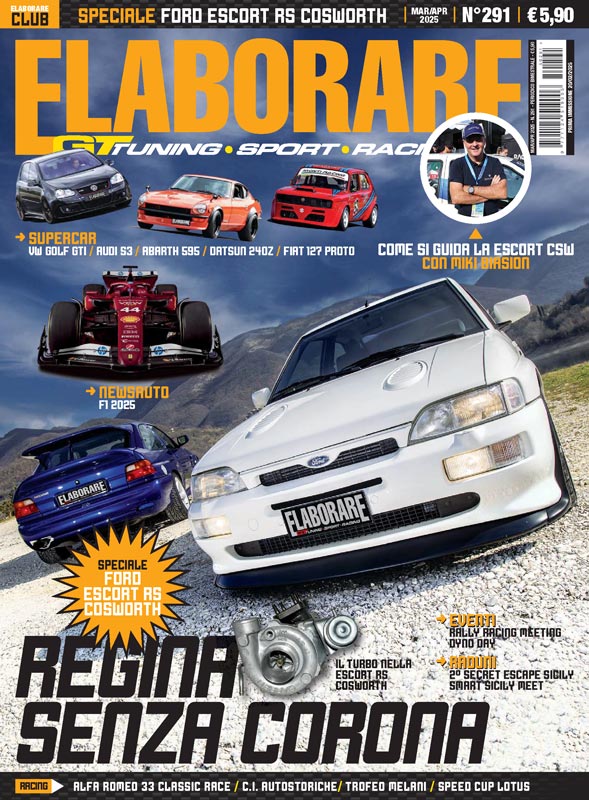.flaticon.flaticon-piston:before, .flaticon-timing-belt:before, .flaticon-tachometer:before, .flaticon-autolift:before { font-size: 44px; color:#333; text-align: center; display: block; width:100px; } .icons-main-number{ font-size: 24px; }
} p:empty, p:empty:before { line-height:0px; margin:0; padding:0; font-size:0 !important; }
[class^=”flaticon-“]:before, [class*=” flaticon-“]:before, [class^=”flaticon-“]:after, [class*=” flaticon-“]:after { font-family: Flaticon; font-style: normal; text-align: center; display: block; width: 100%; font-size: 50px; color:#29abef; margin-left:0px; }
We tried it Mazda MX-5 Skyactiv-G 2.0 RFin the setup Homurathe best MX-5 everembellished by the prodigious engine Skyactiv-G 2.0 with 184 HPbrakes Brembo with 4-pumping front calipers, rims Forged BBS, Bilstein setup and seats Recaro. This MX-5 weighs just over 1,000 kg, is all aluminum, is beautiful as sin with sinuous curves alternating with clean cuts (especially in the Premium Soul Red Crystal color…) and goes like a missile!
Mazda MX-5 Skyactiv-G engine
The MX-5's engine is the 2-liter naturally aspirated Skyactiv-G 184 HP and 205 Nm of torquein the latest evolution available since 2018, is frightening in terms of efficiency and performance.

It has about fifteen horsepower less than the idolized Honda K20 (I think that if it weren't a very plugged-up Euro6d-Temp, it would certainly have reached 200 HP), but from 1,500 to over 7,000 rpm indicated on the instrument it is very ready and angry with a spectacular progression and extension.
The best aspirate I've tried in the last 10 years! Then, looking at it, it is also aesthetically beautiful and Mazda didn't have to invent a engine cover to hide bundles of pipes, wiring and various obscenities as we are now accustomed to.
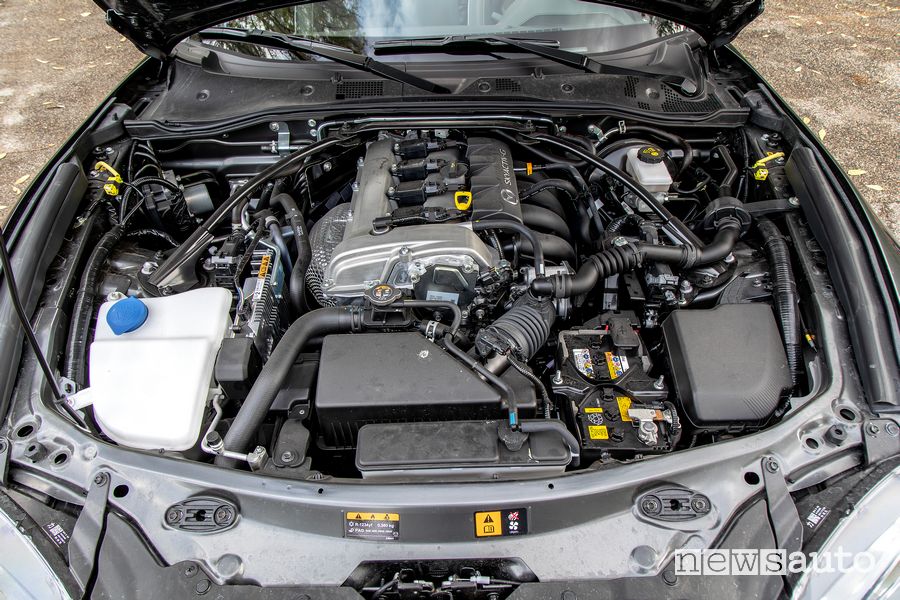
This fantastic naturally aspirated 4-cylinder, twin camshaft 16 valves with intake side phase variator and direct injection system Skyactiv-G is combined with a gearbox that is pure poetry for a driving lover: perfection made 6 gears, which encourages you to use it even when you don't need it, just for the pure pleasure of it. The clutches, ergonomics of the lever and the ratio chosen are the absolute best.
Renewed suspension and brakes on the MX-5
The standard Mazda MX-5's suspension and brakes, while excellent for road use, may not be so on the track. On this Homura setup we therefore find a Bilstein setup excellently calibrated, the dome bar and the magic Brembo brakes with 4-pumping calipers.
They close the fantastic package you look for BBS black forged and wonderful Recaro seats, which embellish the classic and elegant interiors, making them even more sporty and exclusive.
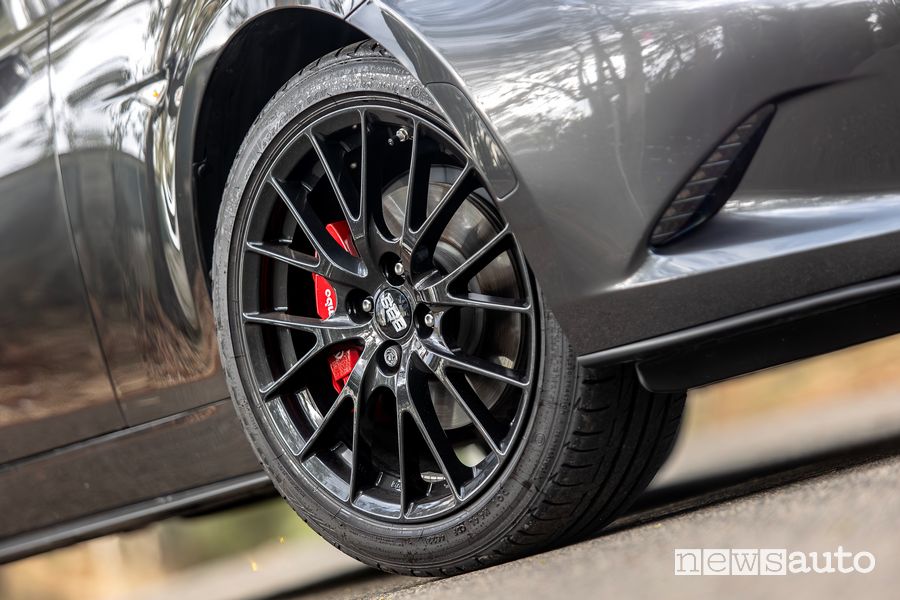
The rest, fortunately, is unchanged: aluminum bodywork, weight just over 1,000 kg in this RF version, front suspension quadrilaterals and later 5-arm multilink. Of course there is also the self-locking rear differential.
MX-5 infotainment
Infotainment? Here too, Mazda goes against the trend, just as we like it. The dashboard and dashboard are not a games room like many latest generation sports cars that are all LED and liquid crystal. Inside this Mazdina there is strictly instrumentation analog enriched only by one small 7″ screen, non-touch, located in the center of the dashboard and controlled by a mouse positioned on the central tunnel. The graphics, operation and functions available are basicbut if for many influencers and YouTubers this is a flaw, for us it's fine like this… all weight saved!

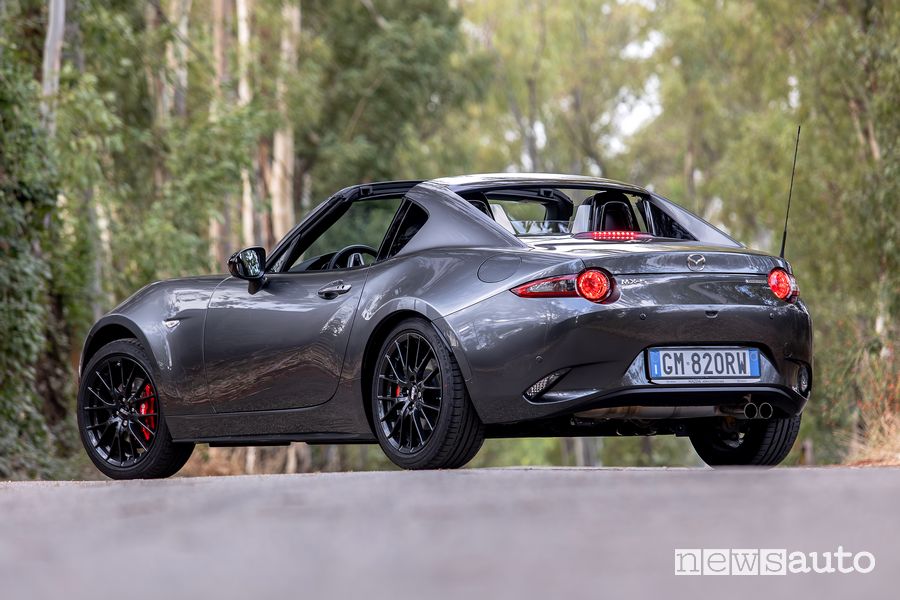

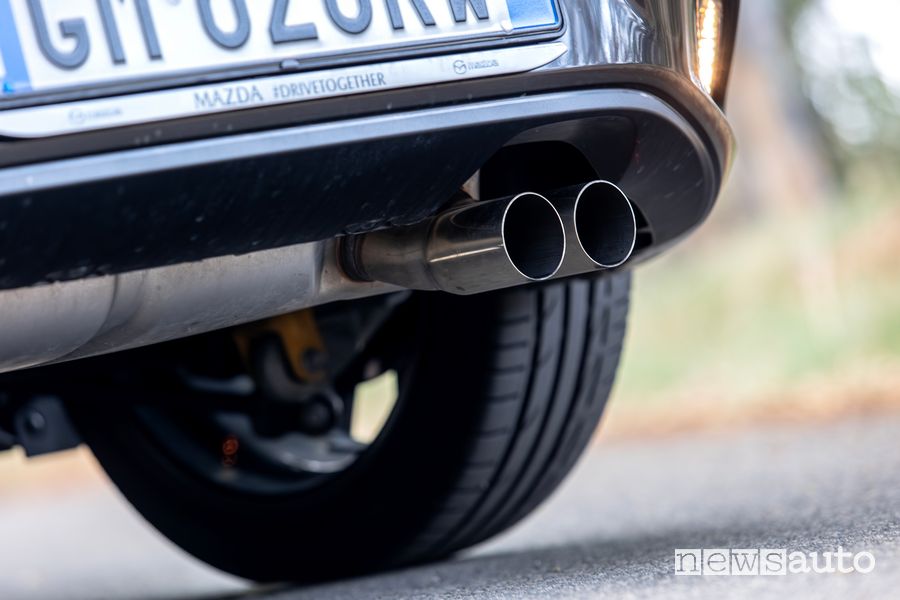
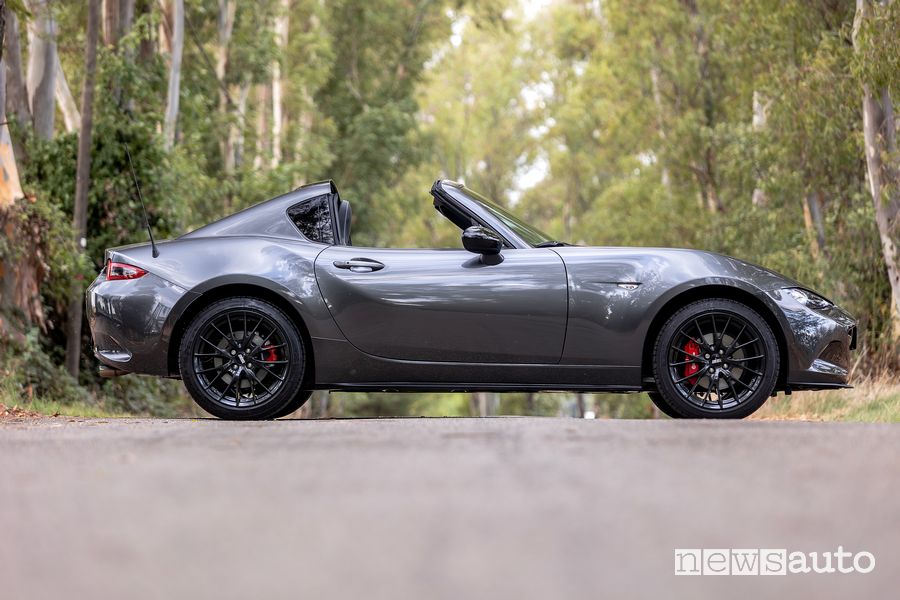
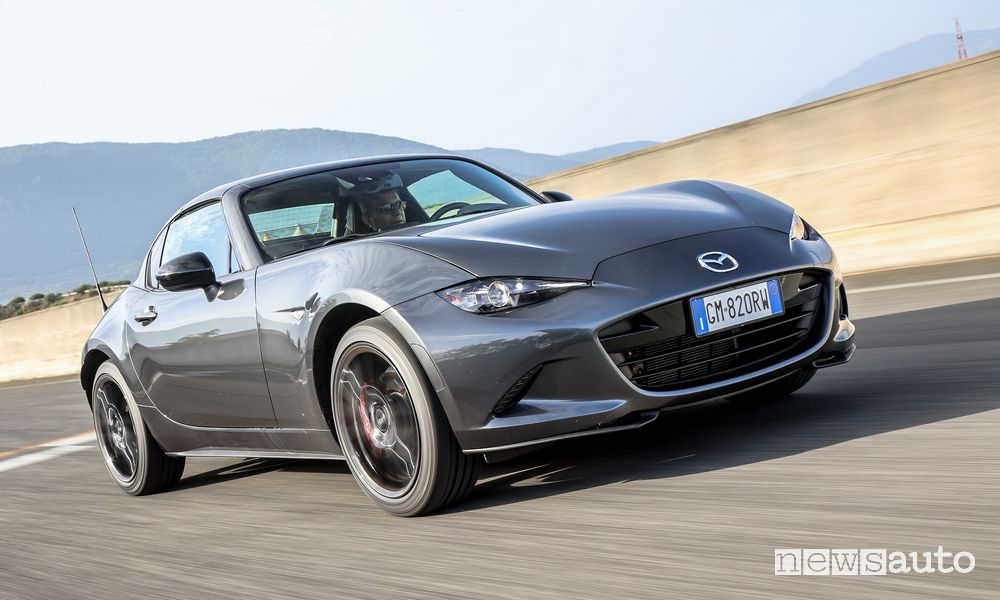
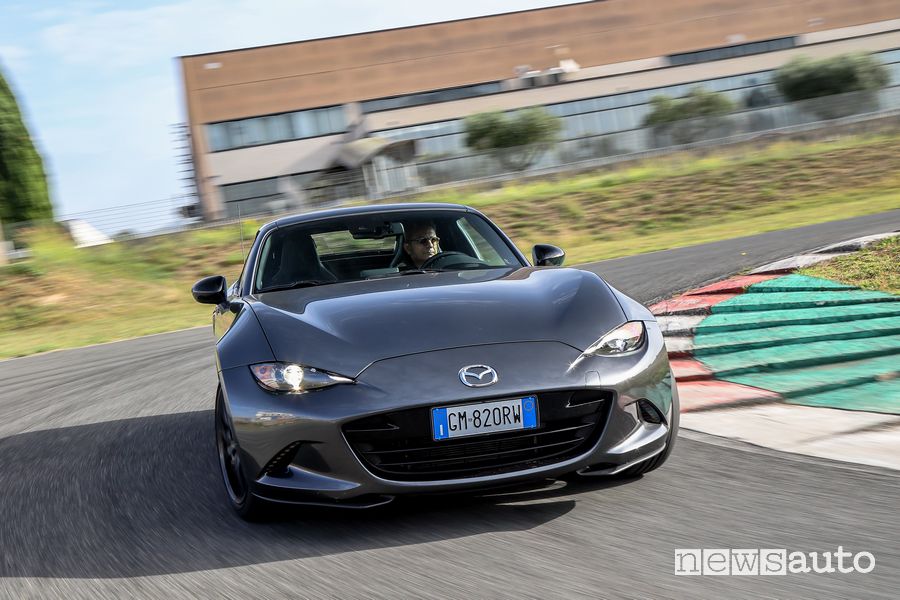

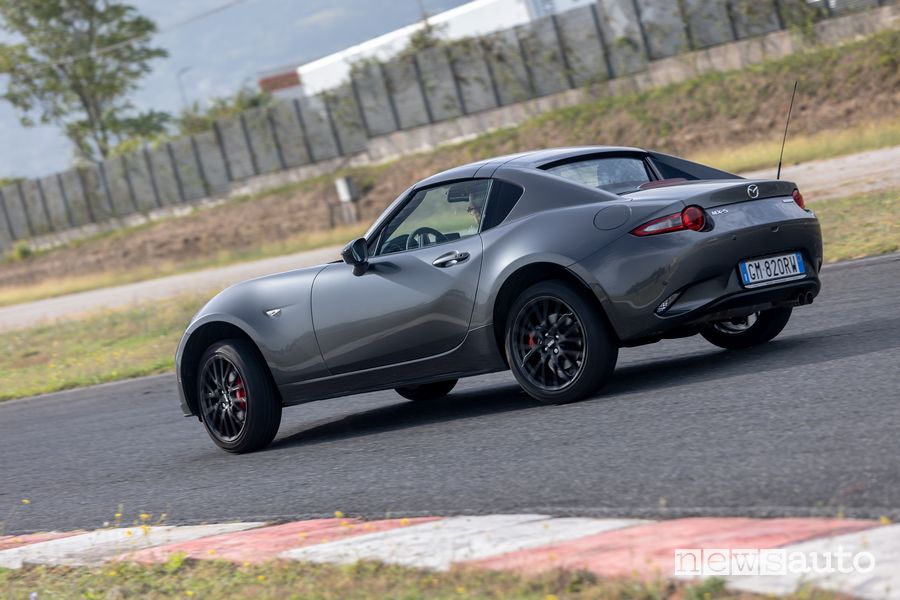
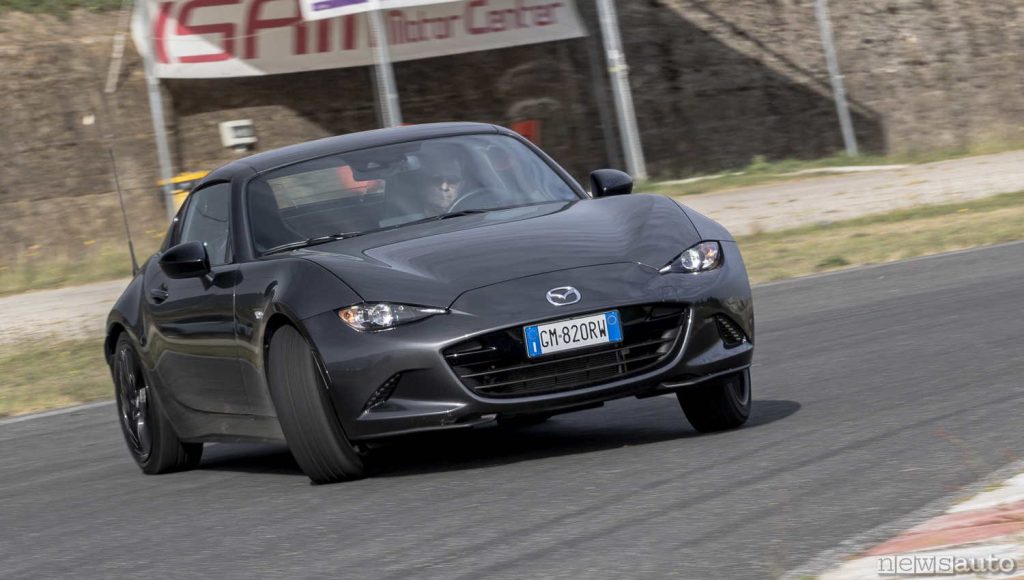
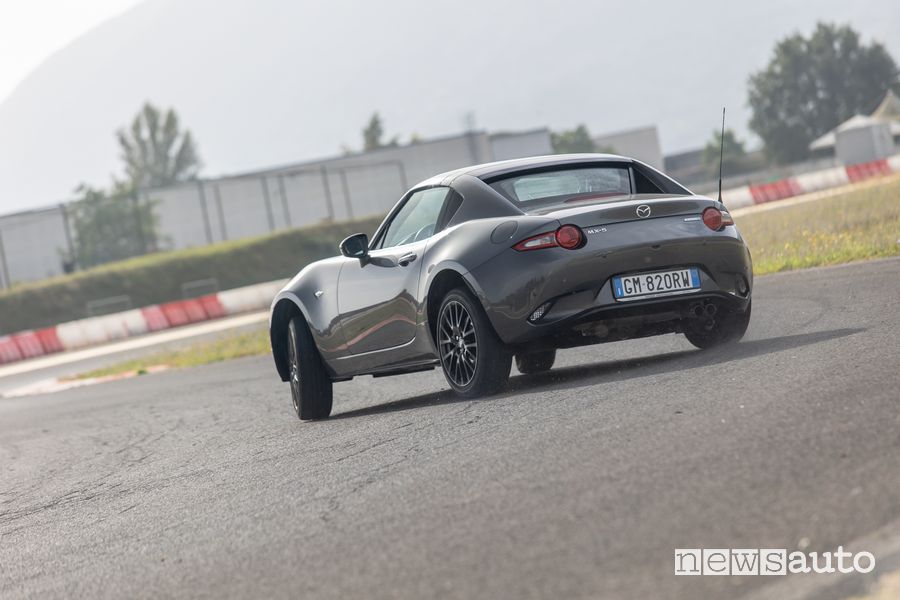

Ah, sorry for them, but on board there is also no compartment spacious enough to contain a latest generation mobile phone with a “seventeen” inch screen connected to Mars; so no ultra-filtered selfies to post on social media… Here only driving pleasure counts!
Aluminum to make it lighter
The MX-5 makes extensive use of aluminum, making up approximately 23% of its structure, a significant increase over previous generations, which used aluminum for approximately 10%. This has allowed Mazda to reduce weight by around 100kg compared to the previous generation, improving acceleration, handling and fuel efficiency. Aluminum components used on the new MX-5 include the bonnet, roof, front and rear fenders, wheel arches and part of the chassis structure.
How does the Mazda MX-5 go
We took it to the track, where driving it is one absolute enjoyment. During the first laps, with the controls disengaged, I oversteer a lot and I can't explain why. I stop and, as my dear father did when he left the pressure gauge at home, I remove the caps from the rear wheels, squeeze the valve and count to 10. I get back on the track and the MX-5 transforms like a kart where the tire pressure is wrong: it's crazy how the car reacts to a small change in tire pressure, but when it is sensitive to small adjustments, it means that the chassis works.

I'm having fun like crazy! I exploit the engine to the limits of the impossible in a straight line, where I arrive at speeds that make 300 HP front-wheel drive cars pale in comparison; then I step on the brake pedal and stop in a patch of asphalt thanks to the featherweight and Brembo system. Turning into corners is lightning fast, with that perpendicular steering wheel on the legs that looks like that of a single-seater. As soon as I enter, I play with the gas by sliding it along, telegraphing with my right foot and feeling every reaction of the rear directly on my backside, since I'm practically sitting on the rear axle.

Then I go out into oversteer and I unload all the gears until the next braking point. On the MX-5 it is so easy to manage oversteer that I can't think of another car that is so fun and safe even when taking it to the limit. Having reached the end of the test I ask myself: “This is a production car that looks fancy… but is there anything that can be done to make it even better?” Definitely yes: the exhaust system.

Aesthetically, the two rear tubes cut like this look like those of a Group N from a few years ago and, between us, hearing the song of this 4-cylinder better wouldn't be bad. A nice freer stooge, in my opinion, would still give her some horsepower. Not bad, right?
Mazda MX-5 Prices
The version we tested is under construction Homuraalso available in Model Year 2024 at dealerships at the price of 43,750 euros. MAZDA prices
Technical information Mazda MX-5, Skyactiv-G
| MOTOR | |
|---|---|
| Displacement | 1,998 cc |
| Bore x stroke | 83.5 x 91.2mm |
| Cylinder valves | 4 |
| Max. power | 184 HP at 7,000 rpm |
| Max. torque | 205 Nm at 4,000 rpm |
| Compression ratio | 13:1 |
| Braking regeneration system | no |
| i-stop system for restarting the engine | Yes |
| PERFORMANCE AND CONSUMPTION | |
|---|---|
| Acceleration 0-100 km/h | 6.8 seconds |
| Full speed | 220 km/h |
| Tank capacity | 45 litres |
| Euro NCAP | 5 stars |
| Consumption (WLTP Combined cycle) | 6.9 l/100 km |
| CO2 values (WLTP Combined Cycle) | 156 g/km |
| DIMENSIONS | |
|---|---|
| Length | 3,915 mm |
| Length | 1,735 mm |
| Height from the ground | 1,236 mm |
| Step | 2,310 mm |
| Luggage volume (VDA) (5-seater mode) | 127 litres |
| Brembo front brakes | self-ventilating and perforated |
| Brembo rear brakes | drilled |
| Brakes, front disc diameter | 280×28 mm |
| Brakes, rear disc diameter | 280×11 mm |
| Empty weight (incl. driver 75 kg) | 1,072 kg |
PHOTO Mazda MX-5 Homura
Read also:
→ 2024 Mazda MX-5 Update
→ All the news about Mazda
→ Used MAZDA ads
→ What do you think? Drop by discussions on the FORUM!
– Infinite engine
– Super trim
– Top brakes
– Perfect gearbox
– Red is even more beautiful!
#Mazda #MX5 #emotions #aboard #Homura #roadster
